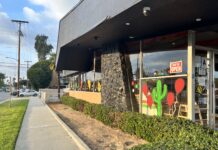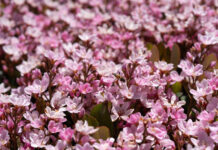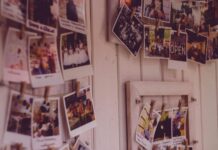
When the newest student center, the Middle Eastern Student Center (MESC), first sprang up last fall, its founders knew the one thing they wanted to hold: a Middle Eastern week. The goal — to enlighten others about the Middle East and to express the diversity of people, ideas and cultures at the joining point of three different continents. “The center — we’re packing microcultures within microcultures,” remarked Mariam Saleh, a board member for the MESC. And through the weeklong series of workshops, fashion shows and dance recitals, each of those microcultures shone through, as bright as the full moon in the blackened night sky.
Origins of Religions
HUB 269 was filled to the brim Tuesday afternoon, as roughly 100 UCR students, staff and community members were in attendance to watch and listen as professors of religious studies Dr. Muhammad Ali and Richard Cunningham gave a presentation on the origins of Christianity, Islam and Judaism.
“Mutuality,” said Dr. Ali, was the term he wanted folks to remember most after they left the “Origins of Religions” workshop.
The event was set up in a Q-and-A format as Director of the MESC Marcela Ramirez posed four questions to both of the panelists in the course of 90 minutes. Cunningham, who spoke about Judaism and Christianity, and Dr. Ali, who informed people about Islam, both answered inquiries that ranged from the founders of each respective religion to the similarities they share with other religions.
Themes of unity and understanding were present throughout the entire workshop. Cunningham, for instance, mentioned that before Judaism and Christianity were considered separate religions, they both actually originated from a single spiritual practice. Likewise, Dr. Ali offered a story about the prophet Muhammad, echoing Cunningham’s sentiments of unity. Muhammad, according to Dr. Ali, once welcomed Christian guests into a mosque and encouraged them to pray in there as they pleased.
As the event went on, more and more students continued to show up to the workshop. At one point, more chairs had to be brought in for the handful of students in the back of the room who stood on their feet because of the lack of seats in the room.
“I’m impressed with so many people giving up their afternoons … to devote themselves to being educated,” noted Cunningham. “Because as technology proliferates … global competency becomes so much more important than it has in the past … We need to understand each other.”
The civil discourse, as it was called by both presenters, ended with question from the audience members, and was followed by a meet-and-greet with both of the panelists.
‘Caramel’ screening
The screening of the award-winning film “Caramel” was not as populated as previous Middle Eastern Week events. From my count, only a little over a dozen people could make it that night. It’s a shame, really — people missed out on not only a good movie, but a chance to immerse themselves in the different cultures and customs of Lebanon that were presented in the film.
“Caramel” depicted the lives of five women in Beirut, each of whom faced her own dilemmas which ranged from marriage, feelings of insecurity and even infidelity.
Throughout the film, audience members got a chance to see some of the customs of Lebanon. The cars that people drive, the occupations that they have, the struggles that they face, the languages they speak — everything was presented there. At some points, I thought to myself: “You know, Lebanon isn’t really that much different from America.” For instance, the fashion statements and even the conversation topics that people engage in are all pretty darn similar to what we see in the U.S. Other times, however, I was really intrigued by how culturally diverse the country is. Personally, I was a little taken aback after realizing that in Lebanon the two commonly spoken languages are both Arabic and French.
Speaking as someone who has spent nearly his entire life in the U.S., I can honestly say this film did what the organizers from Middle Eastern Student Center had probably hoped it would do: It educated me about a different country.
Arab Spring Origins and After Effects
In a room-filled presentation, ASUCR senator and MESC co-founder Shadi Matar led a discussion of the Arab Spring, discussing its successes and failures, its causes and consequences, and its similarities and differences. As the audience engaged in conversation about the efficacy of social media and the promise of democracy, the curtain was slowly pulled back on a region that is often myopically viewed as monolithic.
“When the Arab Spring first happened,” Matar began, “the Middle East was still this orientalized kind of place.” But as became clear in the aftermath of the Arab Spring, it shortly became clear to everyone in the audience that there were differences aplenty. Starting with a simple fruit vendor in Tunisia who protested the government’s policies toward the poor by setting himself on fire, the Arab Spring ignited the region like a spark to dry tinder on a windy Southern California day. Before long, it had spread to dozens of countries.
But the flickers from its flames shed a different light on each place it reached. Syria, with its stockpile of chemical weapons and minority Shi’a population holding power over the Sunni majority, seemed worlds apart from close neighbor Egypt, where the world witnessed the toppling of two consecutive regimes at the hands of the people. Different people, different economies, different religions, different results. And yet, the overarching theme of governments being forced to respond to the people as they raised their voices was ever-present.
As the people in the room rustled around, preparing to leave for the weekend, one of the last videos glimmered forth on the screen, featuring Tunisians for the first time in decades participating in democracy. A 35-year-old man was visibly excited at the prospect of voting for the first time in his entire life. Another woman defiantly proclaimed her willingness to stand in hours’ worth of lines to cast her first ballot. “Anyone who isn’t voting just doesn’t get it.” And the room seemed to collectively stop and nod their heads in agreement.
Week’s End
After the presentation, I followed Matar out of the room and watched as he worked with the MESC student director to begin taking down the posters on the wall across from the HUB. The posters featuring students, all from diverse backgrounds, discussing what the Middle East means to them. The maps of the Middle East, with the pushpins scattered like stars in the sky, showing where students are from: Armenia, Egypt, Palestine and more.
Middle Eastern Week is clearly over. But the future of the Middle Eastern Student Center, and the students who ensured it occurred, seems likely to stretch forward as far as the sky itself.








